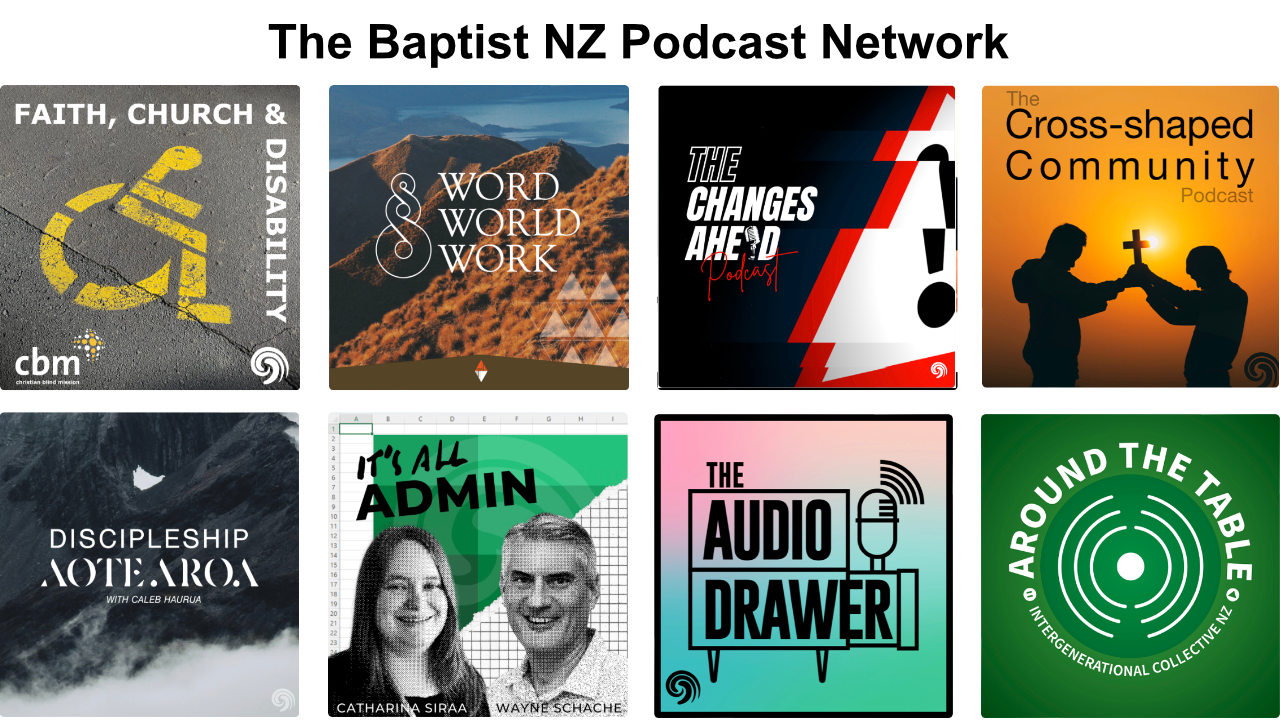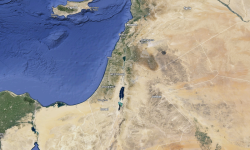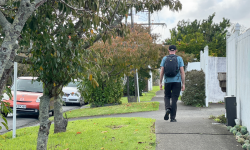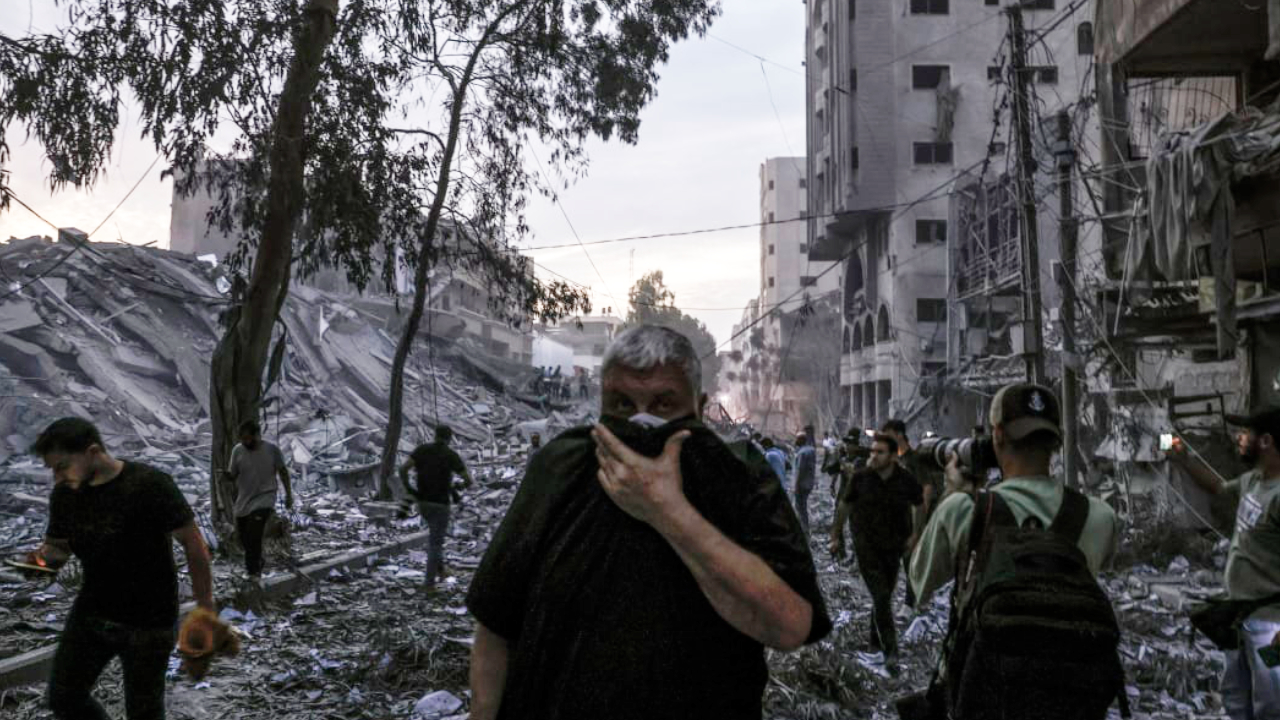
This occasional weekend column called ‘Pondering:…’ is where people from within the 'Team of 40,000 Baptists' can share issues they are thinking about in a way that opens up a topic from a particular perspective. Feel free to comment on these pieces or contribute your own pondering. Opinion pieces are the views of individuals and need to be considered within the context of the diversity of our union of Baptist churches in New Zealand. When commenting or contributing, please follow our Guidelines for articles, opinion pieces and online comments.
This pondering below comes from Robert Davidson, a member of one of our Auckland Baptist Churches.
Reflecting on the historical context for the Israeli/Palestinian conflict
We should be under no illusion that Hamas is a terrorist organisation and that its aim is to eliminate the State of Israel. Of course, the West will not permit that to happen, hence the West’s unwavering support for Israel’s right to defend itself and its recent provision of USD14.5 billion for Israel’s war effort. If there is any doubt as to the aims of Hamas, see the Eight-Part Q & A Primer on Hamas from Dr Mark Durie of Melbourne School of Theology.
Since this link does lack some of the context of the current conflict, I provide it here. It should not be taken as a justification for Hamas’s unconscionable act that took place in October. There can be no justification for what they did on that day.
Soon after this conflict began, I saw an image on TVNZ One News that looked like the 1967 map in the image below. The green shading is Israel, and the yellow shading is the so-called Palestinian Territories made up of two non-contiguous parts, the West Bank (of the Jordan River) and the Gaza Strip bordering the Mediterranean Sea to the West and Egypt to the South. Those who refer to a “Two-State Solution” envisage two independent states, Israel and Palestine, living alongside one another in peace and harmony. However, the reality is far more complex than that, as the progression of the maps indicates.

Source: Info-graphic design by Farwa Rizwan /Al Arabiya English. [if you are viewing on the Baptist NZ app and would like a larger version of this image – view on a web browser here.]
The maps show how the territories have changed over the last century. Prior to the formation of the State of Israel in 1948, about 2 million people lived in what this map calls Palestine (see 1917 and 1946 maps). Whether or not they should be called Palestinians is the subject of furious debate. I leave that aside simply to make the point that they lived there, and they called it home, and apparently, some of them can trace their ancestry back to 400 years of continuous presence there. They were people of mixed ethnicity and religion, including Jews, Muslims and Christians (maybe about 10%), and I understand they lived alongside one another in peace and harmony.[1]
The state of Israel grew out of Zionism. Zionism began as a political movement with the publication in 1896 of Der Judenstaat (The Jewish State) by Theodor Herzl, who proposed that the Jewish people needed a state they could call home. Herzl proposed that it could be in Argentina but ultimately looked to the Middle East and decided that Palestine was the place where it should be established. Herzl’s work coincided with the rise of dispensationalism and, ultimately, Christian Zionism, which brought with it the suggestion that a third temple was to be built in Jerusalem before Jesus could return.
At that time, the Ottoman Empire controlled Palestine but was defeated at the end of the First World War, and control passed to Great Britain under the British mandate. In the late nineteenth and early twentieth centuries, there were British members of Parliament sympathetic to Christian Zionism. Their influence ultimately resulted in what is known as the Balfour Declaration of 2 November 1917, that “a national home for the Jewish people” should be established in Palestine. Britain “gave” 55 per cent of Palestine to the Jewish people for the formation of the state of Israel, which was formed by the UN Declaration on 14 May 1948 (see 1948-1949 map).
The Palestinians opposed the idea that another country could give their land to another people group, and war ensued. They refer to these events as Al Nakba (the Catastrophe). Thousands were evicted from their homes and their villages at gunpoint, giving rise to the largest number of refugees that the world had known. Palestinians fled to Lebanon and Jordan, and their descendants remain in refugee camps in Lebanon and in their own country today, seventy-five years later.
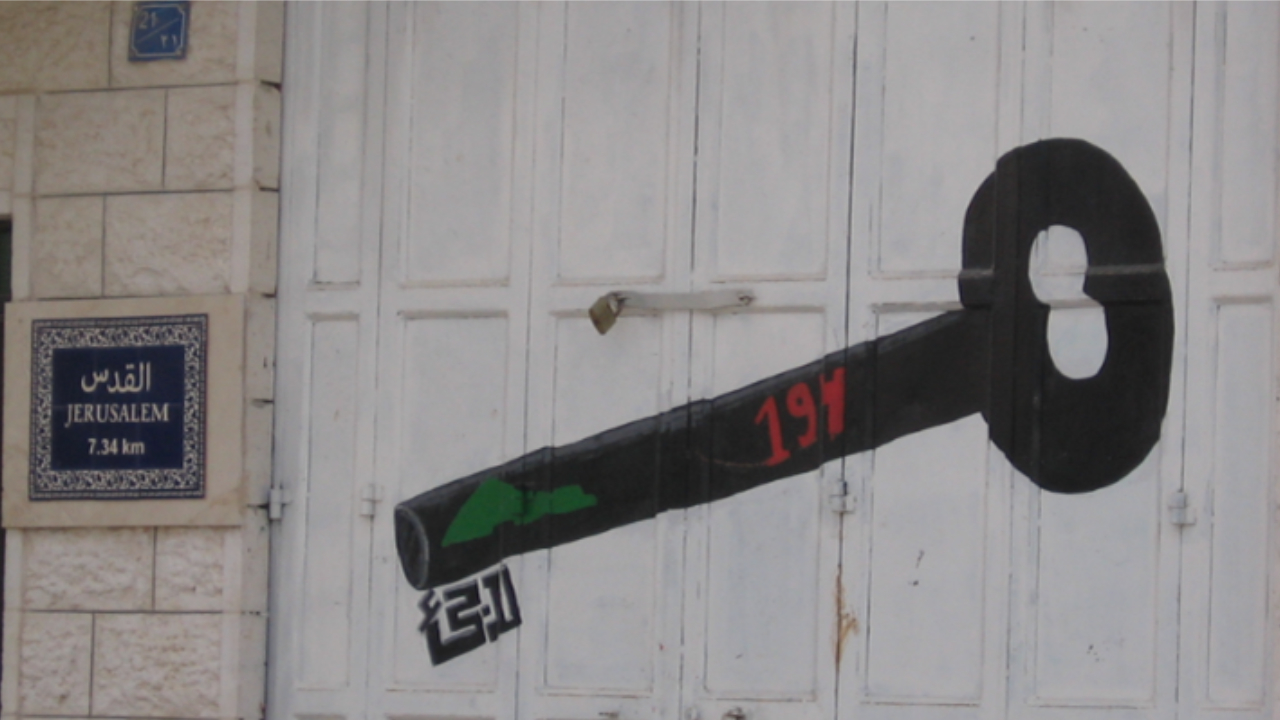
The entrance to the Aida Refugee Camp near Bethlehem
This image is a photograph taken in the Aida refugee camp near Bethlehem in the West Bank. The key is a symbol of the keys to their homes that they still hold, and the “194” on the key is a reminder of the UN Resolution 194 of 11 December 1948, which resolved that:
Refugees wishing to return to their homes and live at peace with their neighbours should be permitted to do so at the earliest practicable date, and that compensation should be paid for the property of those choosing not to return and for loss of or damage to property which, under principles of international law or equity, should be made good by the Governments or authorities responsible.
This Resolution has never been implemented.
Fast forward to 1967, when war broke out again, at which time the Israeli Government took East Jerusalem and more of the West Bank, and also annexed the Golan Heights (territory belonging to Syria) and the Sinai Peninsula (belonging to Egypt). The Sinai Peninsula was returned to Egypt in 1982, but Israel has never relinquished control over the Golan Heights, and technically, Syria and Israel remain at war. This is depicted on the 1967 map in the image above, where Israel now controlled about 73 per cent of the territory.
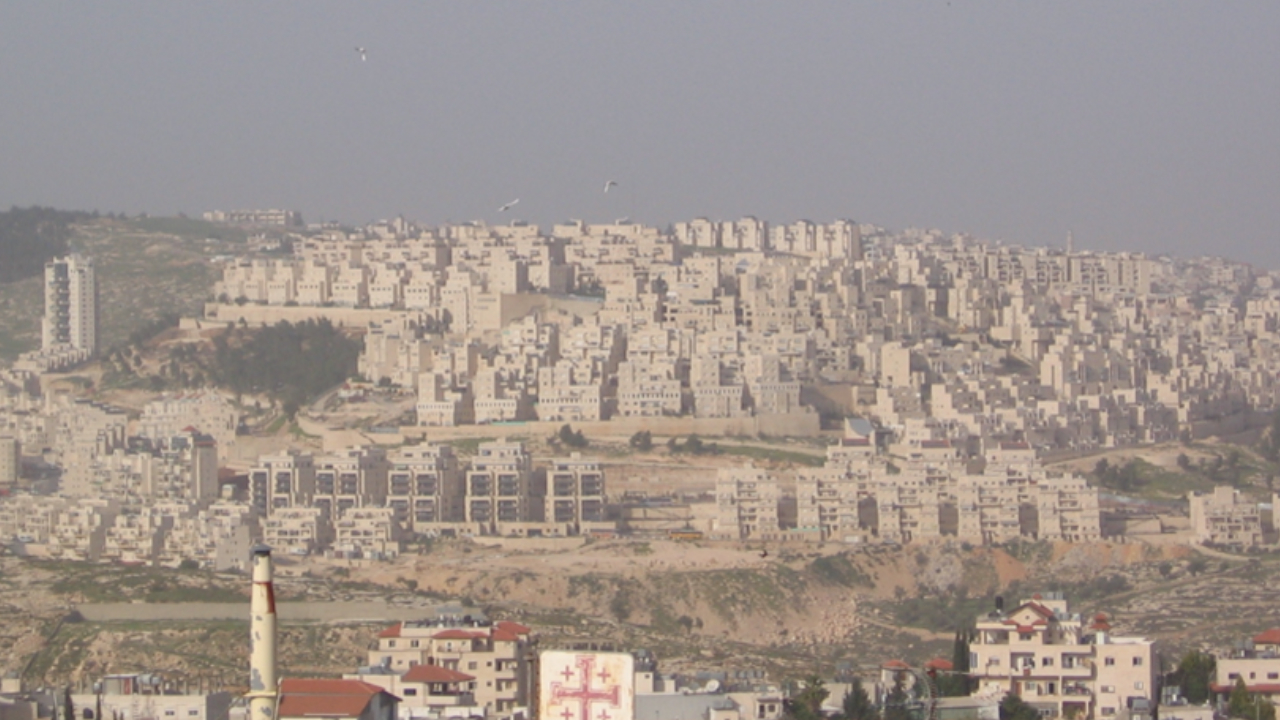
A Jewish settlement outside Bethlehem, with Palestinian homes in the foreground
Following the 1967 war, another development took place as Israel started permitting immigrants to settle in the West Bank and Gaza. These settlements have become one of the major obstacles to peace. With the Israeli Government’s encouragement, immigrants from different parts of the world who have the right to become Israeli citizens enter the country and occupy land that they deem to be unoccupied, starting with motor homes on what they call “outposts”, they eventually build permanent homes in towns sometimes with Old Testament names. There are now around 800,000 Jewish settlers living in the West Bank on land that Palestinians claim has been stolen from them (the “Present” map). So, while technically, Israel possesses 73 per cent of the territory, 800,000 Israeli citizens live on Palestine’s 27 per cent, resulting in a West Bank territory that resembles Swiss cheese, full of holes.
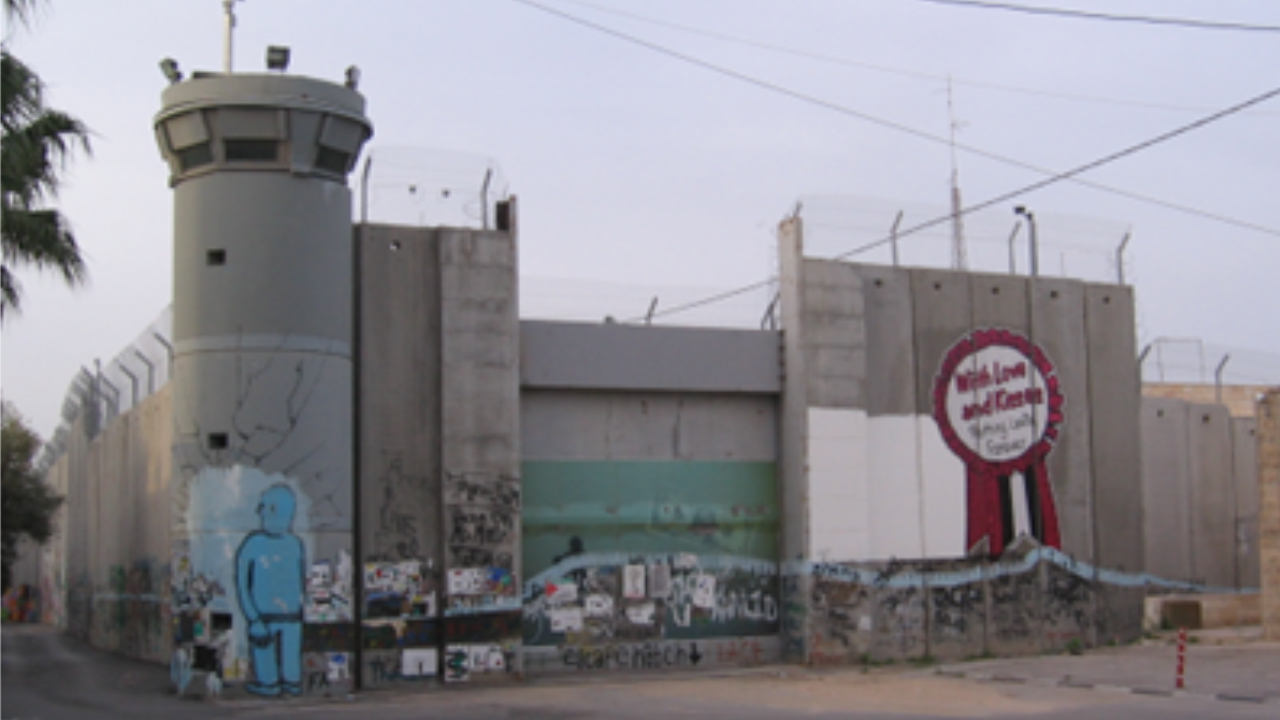
Part of the security fence (separation barrier) near Bethlehem with Graffiti on the Palestinian side
Compounding this state of affairs is the building (starting in 2002) of what the Israeli government terms a “security fence”, ostensibly to keep Palestinian terrorists out of Israel. Palestinians refer to this wall as the “separation barrier.” It is built not on Israeli land but on Palestinian land. Nor is it contiguous, and it does not surround the West Bank. Rather, it snakes around towns and villages, and its effect is to separate Palestinians from one another and from their livelihoods. The ultimate effect of the settlements and the wall is the creation of facts on the ground that make a two-state solution impossible to achieve.
Alongside the settlements and the wall is Israel’s occupation of the West Bank. Members of the Israeli Defence Force patrol the streets, and there are numerous checkpoints, making everyday life difficult for ordinary Palestinians who want to get on with their lives. There are roads that Palestinians are permitted to drive on (with their yellow number plates) and roads that Israelis are permitted to drive on (with their blue number plates), some of which are high-speed motorways connecting settlements with one another and with Jerusalem. Life is relatively easy for Jewish settlers but not for Palestinians.[2]
tWhat I have described for the West Bank was the same for Gaza until about 2005. There were Jewish settlements in Gaza, and there was a military occupation. Then, in August 2005, the settlements were dismantled, and the Israelis moved out. The political situation in Gaza and the West Bank is complex, involving Hamas, the Palestine Liberation Organisation (PLO) and the Palestinian Authority (PA). There is also a group called Fatah, which dominates the PA and the PLO.[3] The PLO originally had as part of its charter the destruction of Israel, but this was removed as part of the Oslo Accords under Bill Clinton’s administration in the mid-90s. Hamas then took over this mantra and added it to their charter.
Around the time Israel pulled out of Gaza, Israel and the West encouraged the Palestinians to hold democratic elections so that there was a legitimate government for Israel and the West to negotiate with. In the West Bank, the Palestinian Authority won the elections, but in Gaza, Hamas was elected. Of course, Israel and the West (probably rightly) refused to recognise Hamas since it has as its aim the destruction of Israel). Nonetheless, Hamas has remained the governing authority in Gaza. Israel built walls and fences around Gaza and set up a blockade so that it controls everything that goes in and out of the territory, including the calorific value of the food in the 500 aid trucks that enter each day. This ensures that nobody is able to overeat (or starve). Unemployment is around 50 per cent. In 2021, the annual GDP per person in Israel was USD52,171, while in Gaza and the West Bank, it was USD3,679. Gaza is about 365 square kilometres, and with a population of around 2,500,000 people, it is the most densely populated territory in the world, with around 7,000 people for every square kilometre, aptly described as the world’s largest open-air prison. Today (6 November), according to TVNZ One News, the UN reports that 70 per cent of the population has been displaced. For me, this population density and displacement calls into question the often-repeated claim that Hamas uses civilians as human shields.
I write none of this to excuse the recent atrocities that Hamas carried out against Israel. Violence is to be deplored and is inexcusable. However, I do write this in an attempt to set a context for the violence and warfare that is continuing day by day. While Hamas has declared its aim to be the destruction of Israel, the Israeli Government has not said the same about Palestine (although it has said this about Hamas, and thousands of civilians, men, women and children have been killed in Israeli airstrikes, dying as so-called collateral damage). But by their actions on the ground, Israel is setting in place conditions that make life impossible for the Palestinians and the people of Gaza, and ultimately, a separate Palestinian state will become impossible.
I pray for the peace of Jerusalem, and my heart weeps for the men, women and children of Gaza. I also pray for the peace of Bethlehem and for Gaza, knowing that Jerusalem will not have peace and security until Bethlehem and Gaza have freedom and justice.
Resources
I have put together this list of resources that provide further context for the current conflict in the Middle East.
A compilation of all church statements on the Israel/Palestine conflict
Complied by Jason Goroncy (lecturer in systematic theology at Whitely College) Church Responses to the Palestine–Israel Conflict | (jasongoroncy.com)
Some Palestinian Christian Voices
> Bethlehem Bible College is an evangelical theological college situated in Bethlehem, just 7 km south of Jerusalem. The speaker in this YouTube clip is Rev Dr Jack Sara, President of the College.
> Musalaha is the Arabic word for “Reconciliation”. Musalaha is a faith-based organisation that provides opportunities for Palestinian and Israeli people to meet together on camps and retreats and seek to understand one another, and so find spaces for grassroots reconciliation. Follow Musalaha on Instagram. Scroll down the lament on the right. Check out their website: musalaha.org
> An open letter from Palestinian Churches to Western church leaders and theologians
> A sermon preached in Bethlehem by Dr Munther Isaac from the Bethlehem Bible College on 22 October 2023.
Recent podcasts
> This podcast is an interview on the Regent College podcast with an American Jewish woman. Listen here.
> This podcast, also from the Regent College podcast, is an interview with a Palestinian Old Testament Scholar, Dr Yohanna Katanacho. Listen here.
> This podcast is from the Theology in the Raw podcast, where New Testament scholar, Preston Sprinkle, interviews Palestinian Christian, Daniel Bannoura. Listen here.
> This podcast is from the Theology in the Raw podcast, where NT scholar Preston Sprinkle interviews a Zionist Jewish Rabbi’s perspective on the war in Israel-Palestine: Rabbit Hanan Schlesinger. Listen here.
Books by Palestinian authors
Awad, Alex. Palestinian Memories: The Story of a Palestinian Mother and her People. Bethlehem: Bethlehem Bible College, 2008.
Alex Awad is the now retired former Dean of Students at Bethlehem Bible College. His father was killed in the crossfire in Jerusalem in 1948. Awad’s mother brought up her seven children encouraging them never to seek revenge. All seven children became prominent Palestinian Christian leaders.
Awad, Bishara and Mercy Aitken. Yet in the Dark Streets Shining: A Palestinian Story of Hope and Resilience in Bethlehem. Cliffrose, 2021.
Bishara Awad is Alex’s older brother, and the founder of the Bethlehem Bible College. This is Bushara’s biography.
Alexander, Paul, ed. Christ at the Checkpoint: Theology in the Service of Justice and Peace. Eugene, OR: Pickwick, 2012.
Palestinian Christian leaders run a conference every second year called Christ at the Checkpoint. This book contains several papers presented at the first conference, held in 2010. The next conference is from 21–26 May 2024 (christatthecheckpoint.bethbc.edu).
A voice from an Israeli political organisation
The Israeli Committee Against House Demolitions (ICAHD), which is committed to bringing peace with justice to the land of Israel/Palestine, often working alongside Christian organisations.
A voice from British Christian Aid and Development Charity
Embrace the Middle East, which has been operating in the Middle East for many years. Their website has a link to up-to-date news from the present conflict in Gaza, as well as many other resources.
Books concerning Christian Zionism and Christianity in the Middle East.
These books are all available from Amazon, many with Kindle editions.
Gary Burge is a New Testament scholar who teaches at Calvin Theological Seminary in the USA. He previously taught for 25 years at Wheaton College:
Burge, Gary M. Jesus and the Land: The New Testament Challenge to “Holy Land” Theology. London: SPCK, 2010.
Burge, Gary M. Whose Land? Whose Promise? What Christians Are Not Being Told about Israel and the Palestinians. Cleveland, Ohio: Pilgrim, 2003.
Colin Chapman now retired in Cambridge, UK taught at the Near Eastern School of Theology in Beirut for forty years:
Chapman, Colin. Whose Holy City? Jerusalem and the Israeli-Palestinian Conflict. London: Lion Hudson, 2004.
Chapman, Colin. Whose Promised Land? 3rd ed. Oxford: Lion, 2002. This book is a thorough history of the conflict in the Middle East from its earliest days until 2002.
Donald Lewis taught Church History at Regent College in Vancouver, British Columbia, until his death in 2019. He was a respected historian of Christianity who specialised in the history of evangelicalism in the Victorian era when Dispensationalism arose in England. He has written two books on the History of Christian Zionism. His 2010 book is an academic work, while the 2021 book is a more popular presentation:
Lewis, Donald M. The Origins of Christian Zionism: Lord Shaftesbury and Evangelical Support for a Jewish Homeland. Cambridge: Cambridge University Press, 2010.
Lewis, Donald M. A Short History of Christian Zionism: From the Reformation to the Twenty-First Century.Downers Grove, IL: IVP Academic, 2021.
Stephen Sizer is a retired English Anglican priest who now runs an organisation called Peacemaker Mediators:
Sizer, Stephen. Christian Zionism: Road-map to Armageddon? Leicester: IVP, 2004. This book is a published version of his PhD thesis from Middlesex University
Donald Wagner is an American Theologian, co-founder of Evangelicals for Middle East Understanding. He has written several books on Christianity in the Middle East, including:
Wagner, Donald E. Anxious for Armageddon: A Call to Partnership for Middle Eastern and Western Churches. Scottsdale, PA: Herald Press, 1995.
Wagner, Donald E. Dying in the Land of Promise: Palestine and Palestinian Christianity from Pentecost to 2000. 2nd rev. ed. ed. London: Melisende, 2003.
Wagner, Donald E. Glory to God in the Lowest: Journeys to an Unholy Land. 2nd revised edition. London: Melisende, 2003.
Peter W. L. Walker is a British Anglican scholar, now in retirement. Walker previously taught at Wickliffe Hall, University of Oxford. He has published extensively on the temple and Jerusalem both in the Bible and in the modern world:
Walker, Peter W. L. “Centre Stage: Jerusalem or Jesus?”. Cambridge Papers 5, no. 1 (1996). This is a brief (4–5 pages) journal article written in connection with the 3000th anniversary of the founding of Jerusalem in 1996. This paper is available on request.
Walker, Peter W. L. Jesus and the Holy City: New Testament Perspectives on Jerusalem. Grand Rapids: Eerdmans, 1996. This book examines Jerusalem, the Temple and the land in every book of the NT. It is a fine piece of exegetical work.
Books, and article and blog by New Zealanders
Church, Philip, Peter Walker, Tim Bulkeley, and Tim Meadowcroft, eds. The Gospel and the Land of Promise: Christian Approaches to the Land of the Bible. Eugene, OR: Wipf & Stock, 2011. This is a book of essays published after a one-day symposium on the promised land held at the Laidlaw Carey Graduate School in 2009.
Church, Philip. “Dispensational Christian Zionism: a Strange but Acceptable Aberration or a Deviant Heresy?”. WTJ 71 (2009): 375–98. This article is available on request.
Church, Philip, “Water.” laidlaw.ac.nz/blog/2011/water.
Donaldson, Alistair. The Last Days of Dispensationalism: A Scholarly Critique of Popular Misconceptions. Eugene, OR: Wipf & Stock, 2011. This is a published version of Alistair Donaldson’s MTh thesis from Laidlaw College.
Photo credits
Top image: Mohammed Abed, People walk atop the rubble of a tower destroyed in an Israeli air strike in Gaza City, October 2023. Source: RNZ
All other photos are taken by Robert Davidson.
Footnotes
[1] I learned this in a conversation with Alex Awad, an Arab Christian who lived as a child in Jerusalem before the State of Israel was formed.
[2] For a description of life in the West Bank written in 2011, see: laidlaw.ac.nz/blog/2011/water.
[3] tThe situation is complex. See this recent report: aljazeera.com/news/2023/10/11/what-is-the-palestinian-authority-and-how-is-it-viewed-by-palestinians. Be sure to click on some of the links to see the relationships between the groups and their history.
More opinion?
Read other contributions to our ‘Pondering...’ column here.
ADVERTISMENT
The Baptist NZ Podcast Network: more than 90 episodes of great content:
